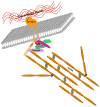Focal adhesion kinase regulation of mechanotransduction and its impact on endothelial cell functions
- PMID: 21741394
- PMCID: PMC3218242
- DOI: 10.1016/j.mvr.2011.06.007
Focal adhesion kinase regulation of mechanotransduction and its impact on endothelial cell functions
Abstract
Vascular endothelial cells lining the blood vessels form the interface between the bloodstream and the vessel wall and as such they are continuously subjected to shear and cyclic stress from the flowing blood in the lumen. Additional mechanical stimuli are also imposed on these cells in the form of substrate stiffness transmitted from the extracellular matrix components in the basement membrane, and additional mechanical loads imposed on the lung endothelium as the result of respiration or mechanical ventilation in clinical settings. Focal adhesions (FAs) are complex structures assembled at the abluminal endothelial plasma membrane which connect the extracellular filamentous meshwork to the intracellular cytoskeleton and hence constitute the ideal checkpoint capable of controlling or mediating transduction of bidirectional mechanical signals. In this review we focus on focal adhesion kinase (FAK), a component of FAs, which has been studied for a number of years with regards to its involvement in mechanotransduction. We analyzed the recent advances in the understanding of the role of FAK in the signaling cascade(s) initiated by various mechanical stimuli with particular emphasis on potential implications on endothelial cell functions.
Copyright © 2011 Elsevier Inc. All rights reserved.
Figures



Similar articles
-
Focal adhesion kinase regulation of endothelial barrier function, apoptosis, and neovascularization.Microvasc Res. 2012 Jan;83(1):1-2. doi: 10.1016/j.mvr.2011.10.001. Epub 2011 Oct 15. Microvasc Res. 2012. PMID: 22036672 No abstract available.
-
Focal adhesion kinase regulation of neovascularization.Microvasc Res. 2012 Jan;83(1):64-70. doi: 10.1016/j.mvr.2011.05.002. Epub 2011 May 14. Microvasc Res. 2012. PMID: 21616084 Free PMC article. Review.
-
Focal adhesion kinase and endothelial cell apoptosis.Microvasc Res. 2012 Jan;83(1):56-63. doi: 10.1016/j.mvr.2011.05.003. Epub 2011 May 19. Microvasc Res. 2012. PMID: 21624380 Free PMC article. Review.
-
Cross talk between focal adhesion kinase and cadherins: role in regulating endothelial barrier function.Microvasc Res. 2012 Jan;83(1):3-11. doi: 10.1016/j.mvr.2011.08.001. Epub 2011 Aug 16. Microvasc Res. 2012. PMID: 21864544 Free PMC article. Review.
-
Regulation of endothelial cell function BY FAK and PYK2.Front Biosci. 2004 May 1;9:1254-66. doi: 10.2741/1239. Front Biosci. 2004. PMID: 14977542 Review.
Cited by
-
Loss of adenomatous poliposis coli-α3 integrin interaction promotes endothelial apoptosis in mice and humans.Circ Res. 2012 Dec 7;111(12):1551-64. doi: 10.1161/CIRCRESAHA.112.267849. Epub 2012 Sep 25. Circ Res. 2012. PMID: 23011394 Free PMC article.
-
An in vitro correlation of metastatic capacity and dual mechanostimulation.PLoS One. 2018 Nov 14;13(11):e0207490. doi: 10.1371/journal.pone.0207490. eCollection 2018. PLoS One. 2018. PMID: 30427911 Free PMC article.
-
Matrix stiffness regulates vascular integrity through focal adhesion kinase activity.FASEB J. 2019 Jan;33(1):1199-1208. doi: 10.1096/fj.201800841R. Epub 2018 Aug 13. FASEB J. 2019. PMID: 30102569 Free PMC article.
-
The effects of microenergy acoustic pulses on animal model of obesity-associated stress urinary incontinence. Part 2: In situ activation of pelvic floor and urethral striated muscle progenitor cells.Neurourol Urodyn. 2019 Nov;38(8):2140-2150. doi: 10.1002/nau.24152. Epub 2019 Aug 27. Neurourol Urodyn. 2019. PMID: 31452249 Free PMC article.
-
Focal Adhesion Kinase Signaling Mediated the Enhancement of Osteogenesis of Human Mesenchymal Stem Cells Induced by Extracorporeal Shockwave.Sci Rep. 2016 Feb 11;6:20875. doi: 10.1038/srep20875. Sci Rep. 2016. PMID: 26863924 Free PMC article.
References
-
- Alahyan M, et al. The mechanism of smooth muscle caldesmon-tropomyosin inhibition of the elementary steps of the actomyosin ATPase. J Biol Chem. 2006;281:19433–48. - PubMed
-
- Avraham HK, et al. Vascular endothelial growth factor regulates focal adhesion assembly in human brain microvascular endothelial cells through activation of the focal adhesion kinase and related adhesion focal tyrosine kinase. J Biol Chem. 2003;278:36661–8. - PubMed
-
- Berk BC, et al. Protein kinases as mediators of fluid shear stress stimulated signal transduction in endothelial cells: a hypothesis for calcium-dependent and calcium-independent events activated by flow. J Biomech. 1995;28:1439–50. - PubMed
-
- Birukov KG, et al. Magnitude-dependent regulation of pulmonary endothelial cell barrier function by cyclic stretch. Am J Physiol Lung Cell Mol Physiol. 2003;285:L785–97. - PubMed
Publication types
MeSH terms
Substances
Grants and funding
LinkOut - more resources
Full Text Sources
Research Materials
Miscellaneous

